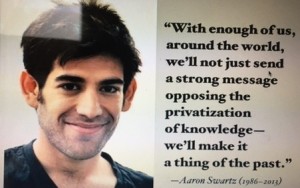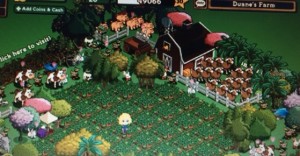Kelly A. Parkes, Katie S. Dredger and David Hicks highlight the critical functions of ePortfolios in supporting student reflection and growth. These tools encourage student teachers to take responsibility for their own learning and to engage in improved delivery of the curriculum and self evaluation. The challenge here is for students to embrace and effectively employ the new technology, using it as a means of providing scaffolding for their students, as well as assessing their progress in learning and development. One of the invaluable outcomes of this activity is the kind of metacognitive awareness that allows the student teacher to rationalize the choices he makes and to articulate his pedagogical decisions.
The ePortfolio supports networking, helps to create important linkages, provides students with a database, and allows for organized storage of student work that has been compiled over a period of time. Through the use of ePortfolios, students have an empowering forum for discussing issues, engaging in information-sharing and offering comments to their peers. The creation this community of learners, supports the development of critical thinking and decision making, both of which challenge students to make revisions that would improve the quality of teaching. The final outcome of this engagement, would be student autonomy.
As I read the article by Parkes, Dredger and Hicks, I thought of the blogs I had created for EGL 614, and decided to evaluate them individually, then reflect on how collectively, they have contributed to my own growth as a student. Incidentally, this class introduced me to a dimension I had not experienced before as I had never created a blog. Therefore going on various websites to find those which allowed me to create a free blog, was an adventure. After I made a choice and started my first blog, there was a challenge. I needed to add a photograph I had taken, and the relevant icons did not respond. I was puzzled and reached out for help. The reaction I got was ‘are you using Safari?’ I replied in the positive. His immediate reaction was to advise me to use Firefox as Safari would not allow certain actions if it was not satisfied that the website I was on was a safe one. I took the advice and added my media without any problems. This was empowering. Not only was I able to create my first blog, but I was also able to add the media I had selected. Learning by discovery was fun after all.
Blog 1 – Gwen
This was my new experience which included cropping my photo and embedding it. When I completed that task, I felt uncomfortable writing about myself. In my culture this is seen as immodest. Therefore, I had to come to terms with my inhibitions. A few days later, when I reflected, I became convinced that this type of writing could be an excellent starting point for students who were shy or had difficulty generating ideas for compositions.
Blog 2 – Virtual Duet
I have always appreciated Nat King Cole’s singing. I was not as interested in Natalie Cole’s songs. However, when the duet was created, I was amazed by the technical possibilities of the realistic presentation of a father/daughter duet so many years after the father’s passing. I enjoyed the music video and connected this to theories of erasure and remediation, and reflected on the prospects for preserving art for posterity. I also envisioned a classroom setting in which students read the historical context then watched the music video and wrote about it. This would be an ideal way to engage students.
Blog 3 – Holmes in a Digital World
Exploring how technology was used to present major themes in this video gave me ideas as to how improve my lesson planning. I could incorporate a video using the digital technology as a teaching tool for students of drama. Not only would they be able to experiment with the technical tools, but they would also be able to use their creativity to highlight the social, moral, political and other issues of the drama. The Holmes video could be a starting point for looking at flickering signifiers, the signified, the ubiquitous nature of the iPhone and its impact.
Blog 4 – Women in Development
This blog provided material that could be used in Cultural/Social Studies classes. I was moved to write after reading a section of A Cyborg Manifesto. The literature prompted me to look at other works by feminist writers with differing view points and then take a closer look at the United Nations Women and Development programs. Students could be encouraged to read further, then engage in debates on such questions as: How can Women’s Equality be achieved in a world that is so diverse in culture, economics, religion and social structures?
Blog 5 – Clean Fun Playing Farmville
My blog on this topic was inspired by frequently looking at my daughter playing Farmville. I often questioned what advantages other than recreation could be derived from this engagement. I was moved to research the topic and learned of the educational values such as evaluating, planning, executing plans and realizing benefits – all important life experiences. I also learned that there was no empirical evidence to prove that playing video games was addictive. In creating this blog, I also had the opportunity to embed a video and learn that digital tools existed for people to create their own avatars and games. This could certainly be a project that could intrigue students, and it would cater for different learners including those who are visual and tactile learners.
Blog 6 – Research Methods Evolve
The assigned readings demonstrated the benefits and limitations of close and distant reading. This proved informative for anyone making a choice about teaching methods. It was fascinating to see how technology has taken the art of teaching to the point where a practical laboratory session can be conducted in a virtual lab rather than a real lab. This activity would definitely appeal to students who are not afraid of experimenting with the technology, or who are already technology savvy. While print texts still have a role in education, and will not be a thing of the past, the increased use of digital technology in the Science classroom is promising.
Blog 7 – The Vice of Regulation
In researching the issues raised in the video ‘The Internet’s Own Boy,’ I found myself looking critically at the theme of social justice and how adults sometimes react when they feel threatened by anyone, but in particular by the brilliance of a child genius who is posthuman. It is likely, that with the advance of digital technology, more children will be posthuman at an early age. Then all of us, teachers as well, must make the decision as to whether we will harness and support this capability for our educational, cultural and economic advancement, or make criminals of those who dare to go beyond the boundaries of human expectation.
Blog 8 – Sustaining the Masquerade Tradition
This blog takes a close look at the pedagogies which could be useful in motivating students to learn and participate in the cultural art form of masquerading. The most useful approaches would be to build on prior digital knowledge, provide scaffolding where necessary, then withdraw it as students demonstrate that they can move ahead on their own or can achieve their goals by working in collaboration with their peers. The activity would give students the opportunity to explore and create. This program can be extended beyond the classroom to include organizations that are engaged in the preservation of cultural dances.
Conclusion
My blogs encouraged me to look at life through two main lenses – the student, then the teacher. All of the blogs provided invaluable information for the creation and delivery of curriculum. They also encouraged research and collaboration and gave invaluable exposure to new technologies. Cynthia L. Selfe quite rightly, concludes: “The changing nature of communication does suggest, however, that the teaching of rhetorically based strategies for composition – the responsibility of introducing students to all available means of communicating effectively and productively, including words, images, sound – remains the purview of composition teachers.”







